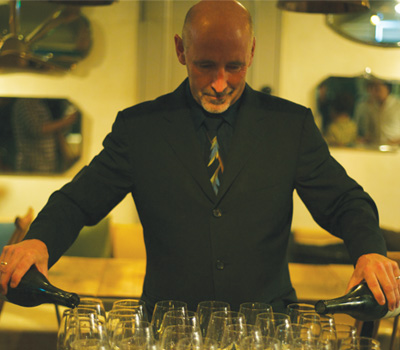Things seem to change slowly at Chez Panisse, where the house red has been the same zinfandel for decades. Regulars will recognize the maitre d’, Jonathan Waters, who has been in the role since the early 1990s—and who also buys the wines. In fact, Waters changes up the wine list often, driven in recent years by the popularity of pairings in the downstairs dining room.


California on a Eurocentric list: pinot noir and the house zin
The Navarro [2011 Anderson Valley Methode Ancienne Pinot Noir, his top-selling wine aside from the house zin] is a matter of a good vintage from a good producer that’s priced below the sweet spot. I had them save 100 cases of 2011 because it was a colder vintage. It’s a very comfortable wine for many people who come here who are not really sure about adventuring. The waiters, too, feel they’ve never had any bad response to it. It’s almost like a house red.
The Green & Red Zinfandel, which really is a house red, sells by far more than any other wine.
With the zin, it’s often the only California red by the glass so it stands out if you want to buy locally. Also, for two years we have done a late night steak special, and the zin is part of that. That sweeps another six bottles a week into its selling speed.
The robust fruity thing that zin has, it appeals to another group who just wants to have a good glass of wine and enjoy themselves. It has enough body and fruit. The same way you and I might drink Muscadet, they might drink zin.
Buying a cool vintage
The [2011] Domaine Eden Cabernet I flip into the glass pour once in a while. The Santa Cruz Mountains cabernets have become more popular. That one is a second label, not too expensive, not as robust as the northern cabs—a Rafanelli Cabernet would be a broader wine. The waiters are behind it and it’s really a balanced wine; it has cooler qualities, mint and eucalyptus. I went really strong on the 2011s, because people who made good wine made very good wine. If the green didn’t come too strongly with the rain and the cold, you made very nice wine.
People say, “You like ’11 because it’s cold. You’re a loser.” Well, some of the wines are good. They suit our food well. And I’ve cellared some of them. I’m looking for slightly lower alcohol and less dominant fruit. So ’11s suit me more than they might suit some other restaurant.
The disappearing $40 bistro wines
The main factor is that my costs have gone up, so the wine list prices have gone up. The list as a general rule has risen a bit, five percent if you think of the middle. Five years ago there were more wines in the $40s, now not so much. The middle is now $60 to $70.
We downsell customers if they let us. If someone points to a bottle and says I want that bottle, you assess them in a bunch of ways if you’re a good listener. Unless they want to spend money and celebrate, I try to sell them down some. If they say pick a wine, the waiters and I are going to pick a wine on a lower price.
We’re trying to stay near this kind of bistro café, even though we’ve been around a long time and may have elevated ourselves above that, most of us want to drink affordable wine—the waiters, the owners and me—which is why we push the less expensive wines a lot. They are not cheap but they are affordable.
A new success: Bruno Debize 2012 Long Fleuve Bugey Blanc
Guests might think, “Oh it’s like a chardonnay.” So they can feel secure. But it tastes different than that—there’s the richness from the aligoté and chardonnay, but there are flavors in it that guests don’t know and they like. The pairing has moved that wine, and we pour it by the glass. It’s one of those clean natural wines, it has no off notes. This one is pretty straight.
Waiter-driven pairings
We didn’t do pairings five years ago with any regularity. We started two to three years ago downstairs, and now eighty percent of the people who drink downstairs are taking the pairing. The list is not used as much.
The waiters are the ones who decide for the evening what they are going to pair. The system of me deciding didn’t work. When we started the pairings, I would decide by the week, look at the menus and set up all the pairings. The waiters would smile and use completely different choices on the evening they were there.
There was initially frustration—“What’s going on here?”—until I realized they wanted to do it themselves. They are smart, with great wine knowledge. If they made the choice themselves, they would be behind the choice and it worked much better. I had not needed to be in charge. Now we talk about it. I keep them in the loop about what’s coming in and they might say, “Hey, can we get more cabernet?” or something like that.
The waiters are engaged in it. I welcome some of the waiters into my tastings, and I’ll bring something in that they want as long as they are behind it. Part of the wine is the belief and a story: The more the person who’s bringing you the wine is engaged, the more likely you will be engaged. If the person is bringing a wine they’ve been told to bring, they may not bring it with as much heart and you may not receive it as well.
Joshua Greene is the editor and publisher of Wine & Spirits magazine.
















